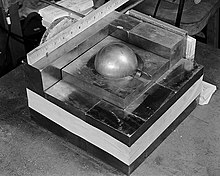Demon core
The core of the device used in the Trinity Test at the Alamogordo Bombing and Gunnery Range in July did not have such a ring.
[1][2] The refined plutonium was shipped from the Hanford Site in Washington to the Los Alamos Laboratory; an inventory document dated August 30 shows Los Alamos had expended "HS-1, 2, 3, 4; R-1" (the components of the Trinity and Nagasaki bombs) and had in its possession "HS-5, 6; R-2", finished and in the hands of quality control.
Material for "HS-7, R-3" was in the Los Alamos metallurgy section and would also be ready by September 5 (it is not certain whether this date allowed for the unmentioned "HS-8"'s fabrication to complete the fourth core).
[3] The metallurgists used a plutonium-gallium alloy, which stabilized the delta (δ) phase allotrope of plutonium so it could be hot pressed into the desired spherical shape.
[4] On August 10, Major General Leslie R. Groves Jr., wrote to General of the Army George C. Marshall, the Chief of Staff of the United States Army, to inform him that: The next bomb of the implosion type had been scheduled to be ready for delivery on the target on the first good weather after August 24th, 1945.
The experiments conducted at Los Alamos leading to the two fatal accidents were designed to guarantee that the core was indeed close to the critical point by arranging such reflectors and seeing how much neutron reflection was required to approach supercriticality.
[6] On August 21, 1945, the plutonium core produced a burst of neutron radiation that resulted in physicist Harry Daghlian's death.
[9] On May 21, 1946,[10] physicist Louis Slotin and seven other personnel were in a Los Alamos laboratory conducting another experiment to verify the closeness of the core to criticality by the positioning of neutron reflectors.
The experimenter needed to maintain a slight separation between the reflector halves to allow enough neutrons to escape from the core in order to stay below criticality.
The standard protocol was to use shims between the halves, as allowing them to close completely could result in the instantaneous formation of a critical mass and a lethal power excursion.
Slotin, who was given to bravado,[11] became the local expert, performing the test on almost a dozen occasions, often in his trademark blue jeans and cowboy boots in front of a roomful of observers.
Enrico Fermi reportedly told Slotin and others they would be "dead within a year" if they continued performing the test in that manner.
[12] Scientists referred to this flirtation with a nuclear chain reaction as "tickling the dragon's tail", based on a remark by physicist Richard Feynman.
Instantly, there was a flash of light; the core had become supercritical, releasing an intense burst of neutron radiation.



